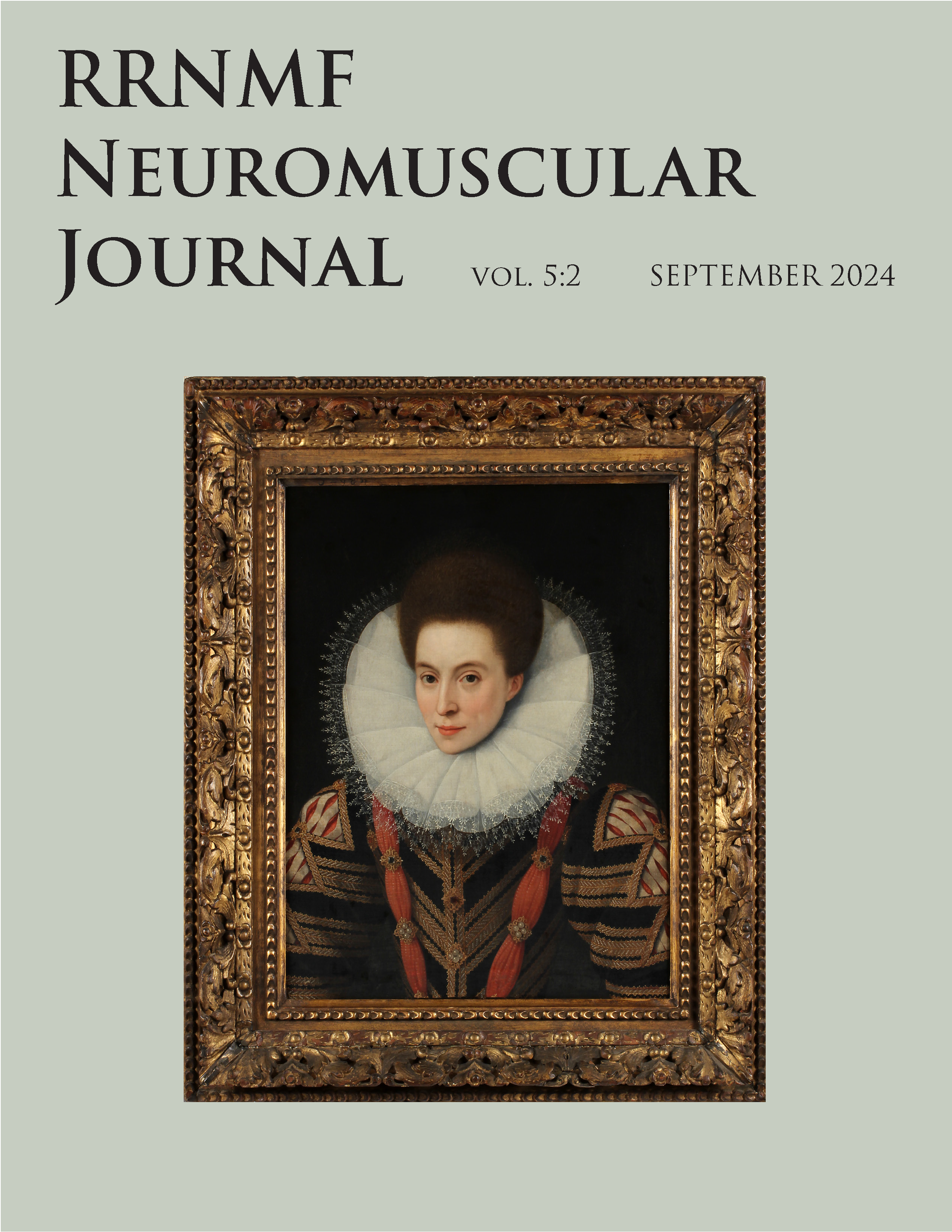Eliciting Latent Myasthenia Gravis Eye Signs Utilizing ‘The Mary Walker Effect’
DOI:
https://doi.org/10.17161/rrnmf.v5i2.21240Keywords:
Myasthenia Gravis, Neuromuscular Junction (NMJ), 'The Mary Walker Effect, Ocular Motility, Ptosis, Fatigability, Functional Neurological Disorder (FND)Abstract
Current standardized tests to induce fatigability in the Myasthenia Gravis (MG) patient do not take into
consideration that, in real-world situations, the patient is using more than one muscle group at a time. In 1895, the
German physician Frederick Jolly, who is famed for coining the name Myasthenia Gravis, observed that exhaustion
of one group of voluntary muscles in a patient with MG induced weakness in other groups that had not been
stimulated. This phenomenon was also noted by Dr. Mary Walker and was named the Walker effect in 1938. The Novel
ocular motility technique described in this paper is designed to engage the extraocular muscles (EOM) simultaneously
with another muscle group namely the facial muscles, specifically testing for lip weakness. This test was named
The SLOW Test (Simultaneous Lip and Ocular Weakness). It was found that observable Myasthenia Gravis Eyes Signs
(MGES) were quicker to elicit and more obvious when performing the SLOW Test. The SLOW Test is a method
designed to confirm the presence of MG signs quickly and effectively, even when there appear to be no obvious
fatigable signs with current testing regimes. The test combines ‘old knowledge’ by testing for the ‘Mary Walker
Effect’ with current ophthalmic testing for MG, which increases fatigue and allows for a higher suspicion level of
generalized MG as another muscle group is simultaneously tested. The development of clinical methods for identifying
latent fatigable muscle weakness is critical to reducing the cases of missed MG diagnosis, testing methods such as the
SLOW Test have the potential to improve patients’ quality of life by enabling earlier diagnosis and initiating earlier
treatment.
Downloads
References
References
Daroff RB. Ocular Myasthenia. In: Kaminski HJ, editor. Myasthenia Gravis and Related Disorders. Totowa, NJ: Humana Press. ; 2003. doi:10.1007/978-1-59259-341-5_5.
Chisari CG, Sciacca G, Reggio E, Terravecchia C, Patti F, Zappia M. Subclinical involvement of eye movements detected by video-based eye tracking in myasthenia gravis. Neurological Sciences. 2023 2023/07/01;44(7):2555-2559. doi:https://doi.org/10.1007/s10072-023-06736-6.
Zhou Y, Kaminski HJ, Gong B, Cheng G, Feuerman JM, Kusner L. RNA expression analysis of passive transfer myasthenia supports extraocular muscle as a unique immunological environment. Invest Ophthalmol Vis Sci. 2014 Jun 10;55(7):4348-59. eng. Epub 20140610. doi:10.1167/iovs.14-14422. Cited in: Pubmed; PMID 24917137.
Layzer RP. Handbook of myasthenia gravis and myasthenic syndromes. Neurological disease and therapy. Vol. 37. New York: Marcel Dekker; 1995. 417-417 p. (Lisak RP, editor. Annals of Neurology; vol. 3). ISBN: 0364-5134. https://onlinelibrary.wiley.com/doi/abs/10.1002/ana.410370329.
Hake A, Kaminski HJ. Ocular Myasthenia Analysis of Diagnostic and Treatment Options. Huang F-P, editor.: Shanghai; 2011. (vol. Autoimmune Disorders). https://www.intechopen.com/books/autoimmune-disorders-current-concepts-and-advances-from-bedside-to-mechanistic-insights/ocular-myasthenia-analysis-of-diagnostic-and-treatment-options.
Weijnen FG, van der Bilt A, Wokke JH, Kuks JB, van der Glas HW, Bosman F. What's in a smile?: Quantification of the vertical smile of patients with myasthenia gravis. J Neurol Sci. 2000 Feb 15;173(2):124-8. eng. doi:10.1016/s0022-510x(99)00319-6. Cited in: Pubmed; PMID 10675656.
Barnett C, Bril V, Kapral M, Kulkarni A, Davis AM. A conceptual framework for evaluating impairments in myasthenia gravis. PLoS One. 2014;9(5):e98089. eng. materials. Epub 20140520. doi:10.1371/journal.pone.0098089. Cited in: Pubmed; PMID 24844418.
Keynes G. The history of myasthenia gravis. Medical history. 1961;5(4):313-326. doi:10.1017/s0025727300026612.
Nguyen-Cao TM, Gelinas D, Griffin R, Mondou E. Myasthenia gravis: Historical achievements and the “golden age” of clinical trials. Journal of the Neurological Sciences. 2019 2019/11/15/;406:116428. doi:https://doi.org/10.1016/j.jns.2019.116428.
Walker MB. Some discoveries on myasthenia gravis: the background. Br Med J. 1973 Apr 7;2(5857):42-3. eng. doi:10.1136/bmj.2.5857.42. Cited in: Pubmed; PMID 4572033.
Lee MR. The miracle at St Alfege's: seventy years on. J R Soc Med. 2007 Feb;100(2):108-9. eng. doi:10.1177/014107680710000230. Cited in: Pubmed; PMID 17277286.
Downloads
Published
Issue
Section
License
Copyright (c) 2024 Suzann Beaupark

This work is licensed under a Creative Commons Attribution-NonCommercial-NoDerivatives 4.0 International License.

